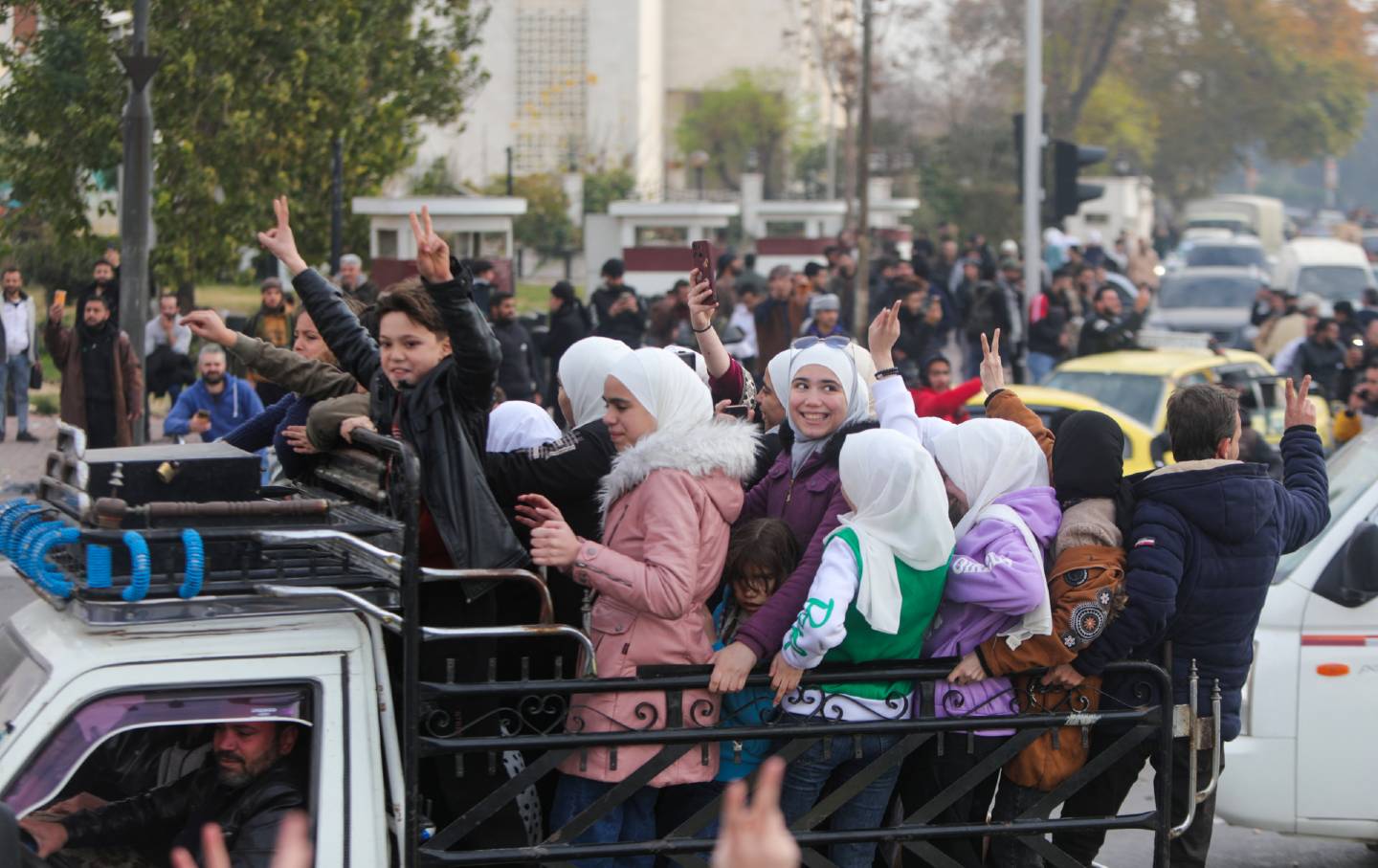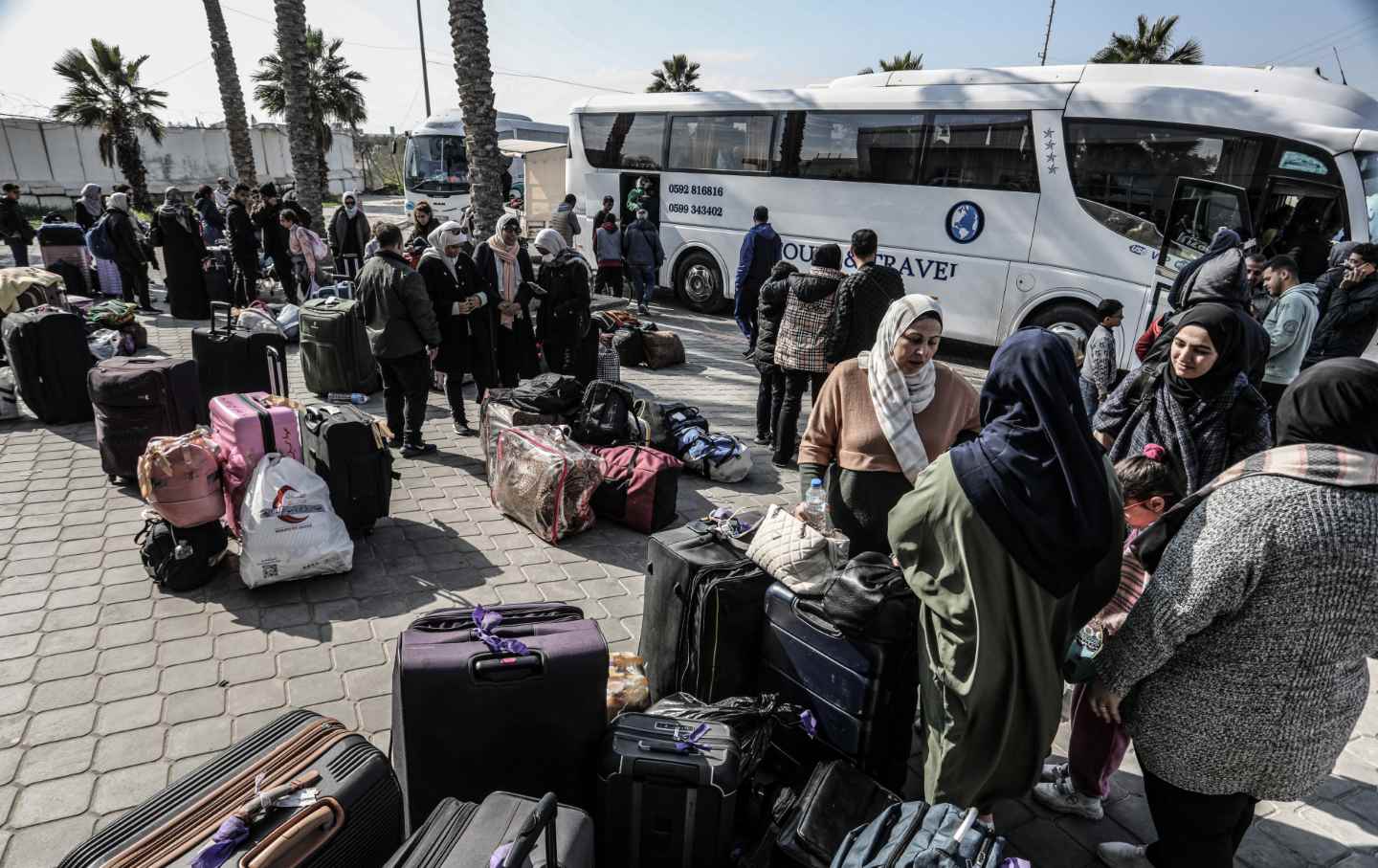Israel Invaded Lebanon Because the United States Let It
The leveling of Lebanese border towns is the continuation of Israel’s Gaza policy: total destruction and ill-defined objectives.

A woman walks past a crater where a collapsed building stood following an Israeli air strike in Beirut’s southern suburbs, on October 7, 2024.
(AFP via Getty Images)
The threats had come so often, in so many different forms, that its start came without much fanfare or outside attention—which is surely how Israel preferred it. There was no massive movement across the Lebanese border, no simultaneous assault from air, land, and sea that blockaded all corners of the Lebanese state at once. Instead, Israel ramped up its air strikes on south Beirut, issuing pinprick building-by-building evacuation orders. Then the announcement came through Israel Defense Force channels: Israel wasn’t invading Lebanon, no; the Israeli army would be launching “limited, localized, and targeted ground raids based on precise intelligence” against Hezbollah in southern Lebanon. No need to fear. Israel was engaging in careful, legitimate self-defense by sending its troops into a sovereign state.
Despite Israel’s insistences that it has been pursuing only something limited and precise, the actual invasion has been anything but.
On September 27, Israel dropped more bunker-buster bombs in one assassination operation in south Beirut, a densely packed suburb, to kill Hassan Nasrallah than were dropped during the entirety of the Iraq War. Supposedly ultra-specific evacuation orders for buildings in the Beirut suburbs have led to mass displacement. Thousands are now seeking shelter on the streets in the capital, and that’s in addition to the hundreds of thousands already displaced by Israeli bombs in the country’s south. The UN estimates that 1.2 million people have been forced to leave their homes. Indeed, what was once an operation supposedly designed to push Hezbollah behind the Litani River may now be an operation to push Hezbollah behind the Awali River, about 20 miles farther north. In addition, Israeli air strikes are now hitting cities farther north than the Awali, farther north than Beirut, hitting Palestinian refugee camps near Tripoli.
Despite the destruction it has wrought, the Israeli invasion has produced few tangible results. The Israeli army’s first engagement with Hezbollah in combat was a disaster, with an attempted crossing into the village of Odaisseh resulting in the deaths of six IDF soldiers. While the IDF has claimed gigantic (so far unsubstantiated) results in the alleged killings of more than 400 Hezbollah fighters, many of its videos of its soldiers moving through Lebanon are of empty mountain ranges, with some videos having been outed as months-old and some images of seized Hezbollah weaponry revealed to have been taken elsewhere. A photo op of the Israeli flag being raised over the Lebanese town of Maroun el-Ras has since been revealed to have been taken at the southern edge, a little over 400 yards from the border, with UN sources saying the soldiers who raised the flag retreated shortly afterward.
If the true intent of the invasion was to stop Hezbollah’s barrages and allow residents to return to northern Israel, things have only gotten worse. Hezbollah has expanded the range of its rocket barrages to Haifa, even launching ballistic missiles on Tel Aviv. Israel’s missile-defense system is revealing its limitations, as Haifa continues to be bombarded with Hezbollah rockets that regularly make impact, and Iranian ballistic missiles appear to be hitting Israeli military bases in the south, despite Israeli reports to the contrary.
This playbook may sound familiar to those who remember the invasion of the Gaza Strip and the IDF’s ongoing operations there. Despite heavy fighting, despite the insistences of already having achieved great victories over Hamas’s combat capabilities and of killing its leaders, Israel’s opponents in Gaza still retain their military cohesiveness and the ability to launch bold attacks, such as the al-Qassam Brigade’s missile attack on Tel Aviv on the anniversary of October 7. There is undoubtedly the matter of Israeli combat ineptitude, evidenced by the videos that emerge whenever IDF soldiers directly engage with Hamas fighters instead of just bombing them from the air. But there is also the matter of the actual intent of the war against Gaza, one whose focus is not exclusively on fighting a militant organization. Israel’s real military objectives are ill-defined but largely bent on mass destruction. This indeterminate destruction is being mirrored now in Lebanon.
What can be seen now in the destruction of Lebanese border towns like Yaroun is the continuation of Israel’s policy in Gaza, one predicated on exacting punishment for standing against what Israel’s prime minister, Benjamin Netanyahu, has called Israel’s “right to win.” Like in Gaza, Israel does not yet appear to have any desire to hold positions or maintain control of populated areas, only to annihilate whatever lies within range of its artillery and its warplanes.
Of course, Israel’s strikes are precise if, as the IDF insists, there are missiles in every garage and in every living room. Of course, Israel is right to destroy entire villages when, as the Israeli newspaper Haaretz describes them, they are “Hezbollah villages.” Of course, Israel is right to depopulate southern Lebanon when, as Israel’s Diaspora Affairs minister claims, they are filled with an “enemy population.”
The prime minister may say one thing in English, when he knows the Americans are listening, speaking of how this war is not with the Lebanese people but with Hezbollah. But when Netanyahu’s officials speak to Israelis, and when the Israeli media that supports Netanyahu speaks to its audience, there is no distinction to be made. The enemy is the Lebanese people.
Popular
“swipe left below to view more authors”Swipe →Despite the reality on the ground, the Biden administration does not appear to see anything amiss. Despite the rapidly expanding scope of these supposedly limited ground raids, State Department spokesman Matthew Miller resists making what he calls a “sweeping characterization” of the nature of the Israeli invasion. Despite the cancellation of almost every commercial flight and nightly bombings near the airport, including the road leading to it, the US Embassy in Beirut insists that American citizens should simply get on the next flight out and says that they will generously provide loans to anyone who cannot afford a ticket. (Loans that people will have to pay back, of course.) Within days of the Hamas-led attacks on October 7, American citizens in Israel received government-chartered flights out of Israel despite the continued operation of Ben-Gurion Airport. When Israeli strikes kill US citizens in Lebanon, State Department spokespeople call them noncitizens, perhaps hoping nobody will bother to correct them.
America is not some bewildered bystander. It enables Israel’s war by sending it weapons, providing intelligence, and protecting it from any checks the international community attempts to implement. The US is also advancing its goals inside the Lebanese state. Axios reports that Washington is pushing for the election of a president in Lebanon now while Hezbollah is weak and disorganized, hoping to perhaps to elevate the head of the Lebanese Army, Joseph Aoun. Lebanon’s presidency has been vacant for the past two years since Michel Aoun (no relation) left office, with Hezbollah’s parliamentarians and their allies pushing for the election of the Maronite Marada Movement’s Suleiman Frangieh and largely blocking the election of independent candidates. While the presidency is not a post as powerful as the prime minister’s, the Lebanese president’s ability to appoint a new prime minister and confirm the cabinet means he would have the ability to displace Hezbollah’s power from government. (Hezbollah currently holds two portfolios, labor and transport).
Israel is similarly pushing for regime change in Lebanon. Netanyahu and Israeli state organs have been pushing for a kind of civilian uprising against Hezbollah while lifting the opinions of members of the Lebanese Forces and Kataeb, whose parties fought on Israel’s behalf during the Lebanese Civil War and massacred Palestinians. But even though these general goals are clear and articulated, there is no detailed plan to make this happen. Netanyahu calls for a cross-sectarian front inside Lebanon against Hezbollah in English, while the IDF spokesman in Arabic antagonizes the population, calling southern Lebanese refugees “ignorant” and dismissing them as “crawling toward an unknown fate.” Israeli government officials talk of wanting a friendly government in Lebanon while other officials speak of its annihilation. For Netanyahu, a pro-Israel Lebanese state would be nice, but no Lebanese state, and no Lebanese people, would be even nicer.
The people who do have a plan, one they want to implement immediately, is the Israeli far right, whom Netanyahu needs to appease to maintain power. Israeli settler groups like the Movement for Settlement in Southern Lebanon have air-dropped leaflets into southern Lebanon saying that the land is theirs, and created fake advertisements for future villas, built on the land once inhabited by the Lebanese population. One settler website appeals to supporters to solicit names for new settlements to be constructed on the rubble of what were once Lebanese towns, with dots lining up and down the map, with some even listed in Syria and in Jordan. Articles in pro-Netanyahu newspapers now debate whether, based on scripture, Lebanon belongs to Israel.
Israel’s impunity has allowed it to destroy Gaza and invade Lebanon. Israel sees the lack of the US government’s concern for, or even mention of, civilian deaths as a signal to escalate, to kill more, to destroy, to besiege, to try to reshape the Middle East. Those who hold power in Israel want to overlook a sea of new settlements built on ruins and mass graves from the Wadi Gaza river to the Litani. The United States sees no reason to stop them. In fact, it’ll build the penthouse.








